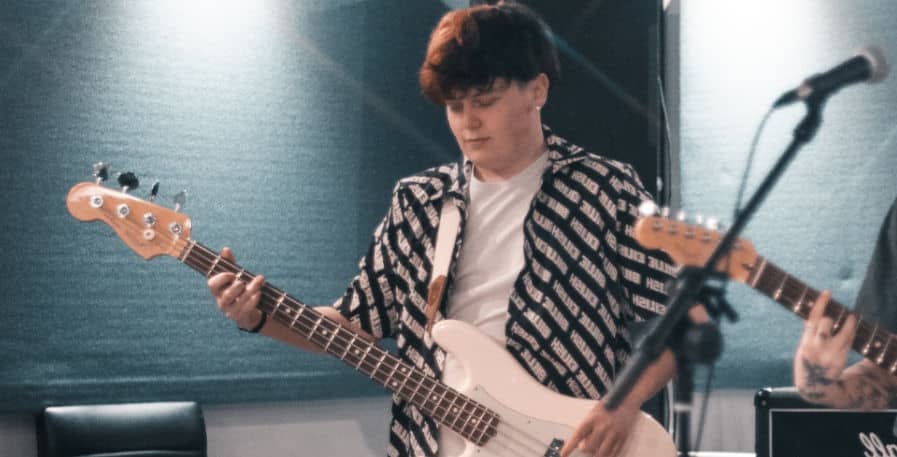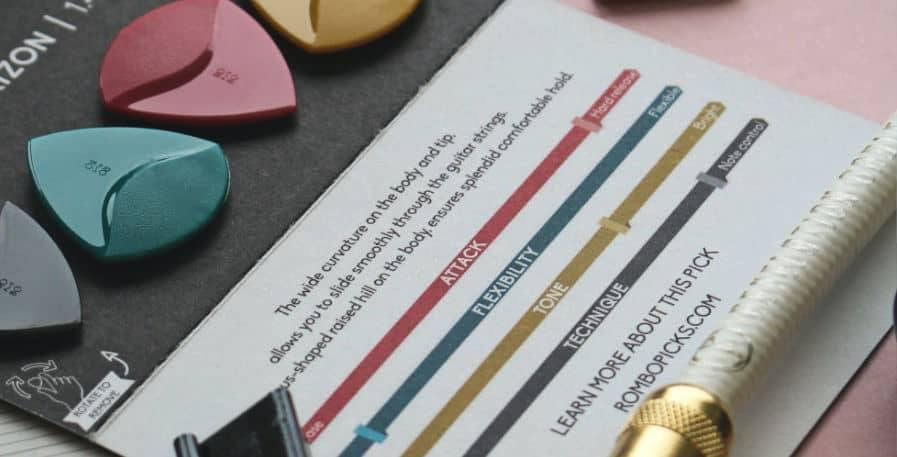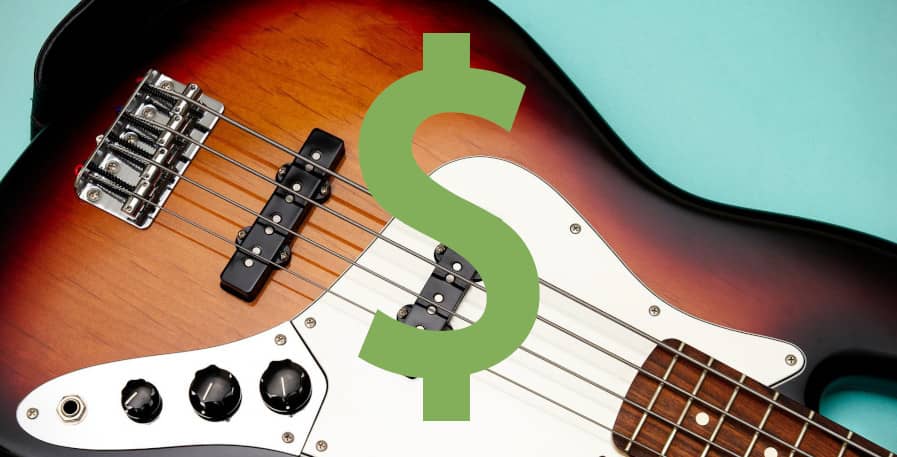For a beginner, it can be hard to judge how much they should pay for a bass guitar.
This is because at first glance it`s difficult to tell what separates a $500 and a $2000 bass. There is also the question of whether it`s a good idea to start out on a cheap bass, or whether it`s better to invest in a more expensive one.
Because of this, I made this article on how much bass guitars cost to help you out.
Below you`ll find how much bass guitars cost at a beginner, intermediate and professional stage. You`ll also find how much common bass guitar models tend to cost. I also go into detail about how much it makes sense for a beginner to spend on a bass, and why some basses can be so expensive.
Lastly, I added a list of some of the additional costs of playing the bass. This way, you won`t run into any hidden expenses down the road and you`ll know exactly what you are signing up for if you decide to pick up this amazing instrument.
How much do basses usually cost?
In general, decent entry-level basses cost approximately $250-$300. Intermediate instruments tend to cost at least $600 and are often priced at $1000 and up. Professional bass guitars tend to go for at least $2000 and often cost significantly more.
At the cheapest, poor second-hand basses get listed for $100 or less regularly. On the other side of the spectrum, Paul McCartney`s Yamaha BB-1200 sold for $496000 at a 2021 auction.
As the cost of bass guitars can vary so much, here is a table that details what the common bass models tend to go for:
| Bass Guitar: | Price range: |
| Fender Precision | $600 – $800 |
| Fender Jazz | $600 – $1000 |
| Musicman Stingray | $400 – $800 |
| Rickenbacker 4003 | $2000 – $2500 |
| Squier Precision | $250 – $300 |
| Squier Jazz | $250 – $400 |
| Gibson Thunderbird | $1500-$1800 |
| Gibson SG | $1200 – $1800 |
| Epiphone Thunderbird | $350 – $600 |
| Epiphone EB-0 | $250 – $400 |
| Ibanez SR300EB | $300 – $450 |
| Yamaha TRBX304 | $400 – $500 |
| Warwick Rockbass Corvette | $700 – $900 |
| Schecter Stiletto | $700 – $900 |
Basses usually cost more if they have 5 strings as opposed to 4 due to them being bigger and less popular.
For the same reason, If you intend to start out with a short-scale bass, expect to pay less than you would for a long-scale bass.

How much should a beginner spend on a bass?
By spending between $200 and $350 a beginner can purchase a bass that is of sufficient quality. This is also often enough of a budget to buy a starting set, that includes everything you need to get started with playing the bass.
I recommend trying different basses and doing your due diligence by reading reviews, as some instruments in this price range will be poor. It is also a best practice to purchase from reputable manufacturers like Squier or Epiphone, which makes decent and affordable instruments.
High-end basses are not directly unfit for beginners. However, there are several reasons why I think it`s preferable to start out on an affordable model:
- Indifference – A beginner might struggle to tell the difference between a cheap and expensive bass.
- Commitment – The beginner might give up on the bass, or switch to a different instrument
- Experience – A beginner has to become knowledgable about the bass before they can know what type of intermediate instrument will suit them the best.
- Sufficiency – There are many basses in the $200 to $350 range that are decent instruments that will not hinder the growth of the bassist.
Thus, for most beginners, I personally believe that it makes the most sense to get a bass in this price range. This is due to them gaining a limited amount of benefits from playing a higher-end bass, which in turn makes it harder to justify the cost.
However, there are cases where I think spending more on a beginner bass can be justified. These include cases such as these:
- Nothing else suits them – The beginner has tried a multitude of basses and only felt comfortable playing a specific model
- Experienced Musicians – They are skilled at other instruments, have band experience, or are an experienced musician
- Knowledge of bass guitars – They are very knowledgeable about bass guitars in general, despite not playing the instrument themselves yet
In these cases, the beginner will have a better idea of what they are paying for when they purchase a more expensive bass. They are thus also more likely to appreciate the benefits of a higher-end instrument.
Why are bass guitars expensive?
Bass guitars are expensive due to their size and lack of demand. The lack of demand means bass guitars cannot be mass-produced at the same rate as guitars, which comparatively brings up the cost. The size of the instrument also makes them more expensive to manufacture in general.
Thus, when comparing basses and guitars of similar quality, basses tend to cost more on average. This difference is even more noticeable when it comes to strings and spare parts.
As for why some bass guitars are more expensive than others, this mainly comes down to build material, the crafting process, and the quality of electronics. For example, a mass-produced bass made out of alder will be significantly cheaper than a hand-crafted bass made out of snakewood.
These factors also impact how comfortable a bass feels to play as well as the tone of it. Thus, expensive basses generally sound better than cheap ones and feel more comfortable to play.
However, It`s worth mentioning here that playability and sound of a bass are subjective. A higher cost is not a guarantee that a bass will suit a particular bassist. Furthermore, some bassists even prefer the sound of cheaper basses, often citing their raw and thin sound as the reason.
An upside to some expensive basses is that they can be more of an asset than a liability. What I mean by this is that as long as the instrument is kept in good condition, it won`t depreciate in value.
The value can in some cases even increase and you can make some money if you decide to sell your bass guitar later on.

Other expenses for bass players
In addition to the bass itself, there are some additional costs associated with playing the instrument.
A good option for beginners is to buy a bass starter kit. This will include everything you need to get started with playing the bass, such as a strap, amplifier, and instrument cable.
A kit does however not take care of all the expenses you will run into down the road. Thus, here is a full list of them.
Bass strings
When buying a new bass, it will be strung with a fresh set of strings. In time though, these strings will become worn out and need to be replaced.
Bass strings can be reused if cleaned properly, but this will become less effective with time. Thus, as a best practice, I recommend switching bass strings every 6 months or so, and at least once a year.
In general, a set of bass strings tend to cost between $20 and $30. Thus, in order to keep your strings sounding fresh and in good condition, expect to pay about $40 to $60 a year.
On occasion, you might also need a new set because of the bass strings rusting, breaking, or becoming damaged. Thus, while these can all be prevented with proper maintenance and technique, they can slightly bump up the cost of maintaining your bass.
Note: Some bassists prefer the sound of dead strings. This is most common among bassists who use flatwound strings and prefer a warm and musky tone over a sharp and clear one. Thus, the cost of strings can be eliminated if this suits your stylistic preferences.
Setup
Setting up a bass consists of adjusting neck tension, string height, action, and intonation so that the bass both sounds and plays as great as possible.
How often a bass needs to be set up varies a lot. I`ve heard some bass plays advocate for regular setups, and recommend getting it set up every 1-2 times a year. Some even recommend setting it up every 3 months or so.
While this does keep your bass in good condition, this is in my opinion redundant in most cases. This will also cost you additional time and money if you get a luthier to set the bass up for you. Therefore, I personally only set my bass up when I notice any issues with it, which happens every other year at most.
Mileage may vary though, and some basses do need more set up than others. Thus, it is best to get it set up if the instrument feels difficult to play, is producing unwanted noises, or sounds consistently out of tune.
The average cost of a bass setup is $63.18 without new strings and $79.54 with new strings.
You can learn to set up your bass yourself, and it is a skill I recommend learning down the road. In the beginning, though, it can be helpful to have a luthier to it for you to ensure that it gets done correctly.
Amplifier
In order to enjoy the full experience of playing the bass, it needs to be amplified.
Decent 10W amplifiers can be found in the $40 – $80 price range. These are small amps that are great for starting out, practicing alone, or for minimalistic jam sessions without a drummer.
For band rehearsals with a drummer or for playing small live shows, I would go with an 60W amp at the lowest. 60W bass amps tend to cost between $150 and $300.
With that said, the bass guitar can be played without an amp. One way to do this is to play it acoustically, albeit this results in a lackluster tone and makes for less effective practice. Alternatively, it can also be played through a PC or Mac with the help of an audio interface.
Accessories
Lastly, there are some accessories that every bassist should have:
| Item: | Use: | Cost: |
| Gig Bag / Case | Makes it safer and easier to transport your bass | $10-$60 (Bag), $40-120 (Case) |
| Stand / Wall Hanger | Makes it possible to store the bass in an upright and safe position | $5-$20 |
| Strap | Used to support the bass against your body and necessary for playing while standing | $10-$50 |
| Pick | Used to pluck the bass when it`s not played with the fingers | $0.40-$3 |
| Instrument Cable | Needed to plug the bass into an amp and produce an amplified signal | $6-$25 |
In my opinion, there is little reason to spend more than the minimum on most of these, with a few exceptions.
First of all, I advise against saving money on an instrument cable by buying one that is too short. This will become tedious in the long run, and prevent you from being able to move during rehearsals and live shows. Thus, I recommend getting one that is at least 3M, and preferably one that is 5M or longer.
Another accessory where cost makes a difference is the strap. This is because a thick and sturdy strap and an appropriate bass strap height make the bass much more comfortable to play. It also enables you to play for longer periods of time and helps prevent back injuries.
Thus, for adequate accessories that will get the job done as well as a good strap, expect to pay approximately $80-$90.
For the same accessories and a cheap strap and a short cable, the cost of everything is about $45-$55
Lessons
In my article on how long it takes to learn the bass guitar, I mention that lessons can greatly speed up how quickly you learn the instrument.
Therefore, bass lessons are generally worth it for anyone who is serious about learning the bass guitar. Especially so if you are looking to do so methodically and fast.
However, lessons are not a necessity, and a lot of great bass players are self-taught. You can also find many decent resources for learning how to play the bass online for free.
In-person one-on-one lessons tend to cost $40 to $60 an hour. It is a common practice to take one lesson a week, which brings the monthly cost to approximately $170-$255 a month. If you are on a budget or find this cost high, half-hour lessons are still very helpful and can cut this cost in half.
Online one-on-one lessons are in my opinion inferior to in-person lessons. After trying both, I found that in-person tutors had an easier time demonstrating techniques, and identifying flaws in my playing compared to online ones.
With that said, both helped me immensely in improving at the bass.
Using an online tutor is a great way to find cheaper lessons, or to get premium lessons from experienced and famous bass players. Thus, they can cost everything from $20 an hour to premiums in the hundreds.
Conclusion
While the cost of bass guitars differs a lot between models, choosing the right bass does not have to be difficult.
It is simply about finding an instrument that feels comfortable to play and fits your physiology and budget. It is fine to buy a higher-end instrument as a beginner, but without the experience to tell all the differences between bass guitars, it is often not a necessity.
Thus, most beginners should be able to find a bass that suits them in the $200 to $350 price range. Whether you prefer a thick or slim neck, or a small-scale or a long-scale, there will be decent options to choose from in this range.
The purchase of a higher-end instrument can be justified if you are experienced or knowledgable about music in general. It can also make sense if you highly prefer a certain bass over more affordable options.
Regardless of what bass you choose, be mindful that there are some additional costs to playing the bass. Most of these are minor, but can in total increase the cost of starting out by $50 to $200. New strings, setups, and lessons are also possible requiring expenses that can further increase the cost.
With that, I hope you got a better idea of how much it costs to play the bass guitar. If you are still on the fence about whether the instrument is right for you, I recommend checking out this article: Should you play the bass?. It`s a helpful resource for finding out whether you will enjoy the instrument in the long run.

